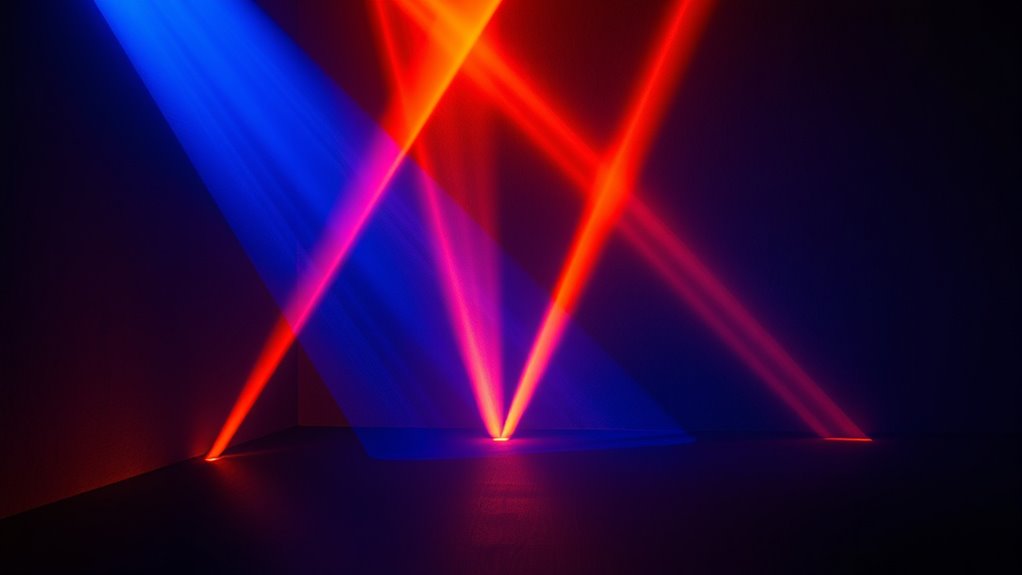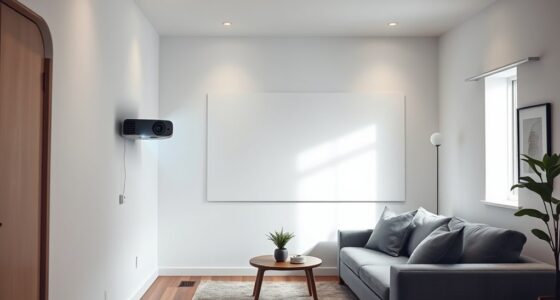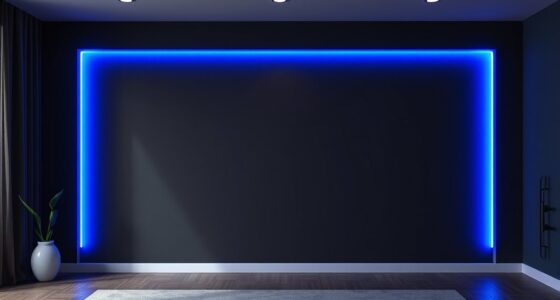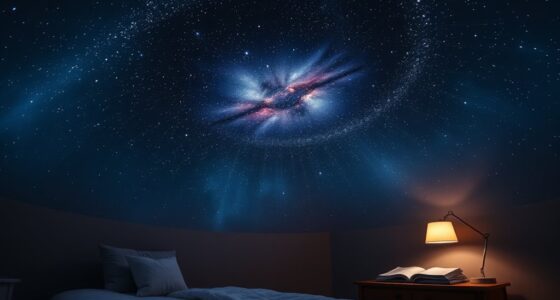To paint with light effectively, layer ambient, task, and accent lighting to create depth and mood. Start with ambient light to set the overall atmosphere, then add task lights to highlight specific details, and finish with accent lighting to emphasize textures or features. Carefully position each fixture to control shadows, contrast, and focus, transforming a simple scene into a dynamic artwork. If you continue exploring, you’ll uncover how to master these techniques for stunning light paintings.
Key Takeaways
- Use ambient lighting to create a soft, overall glow that sets the scene’s mood and provides a base layer.
- Incorporate task lighting to highlight specific details or focal points, guiding viewer attention within the composition.
- Add accent lights to emphasize textures, patterns, or features, creating depth and visual interest through focused highlights.
- Adjust the placement and intensity of each layer to balance shadows, highlights, and contrast for a cohesive scene.
- Experiment with different color temperatures and fixture arrangements to enhance artistic expression and scene depth.

Paint With Light is a mesmerizing photography technique that transforms long-exposure shots into stunning visual art. By skillfully controlling light sources during exposure, you can create images that seem to glow with motion and vibrancy. One key aspect of mastering this technique is understanding how to manage color temperature and fixture placement. These elements directly influence the mood, clarity, and overall impact of your illuminated artwork. When planning your scene, consider how different light sources emit varying color temperatures—warm tones from incandescent fixtures or candles evoke cozy, intimate atmospheres, while cooler LEDs give a sleek, modern feel. Adjust your fixture placement accordingly to highlight specific areas or create contrasts that add depth and interest.
Positioning your lights thoughtfully is essential. For ambient lighting, place fixtures where they can wash the scene with a broad, even glow without overpowering focal points. This creates a soft background that sets the mood without distracting from your main subject. For task lighting, you might want to position smaller, more focused fixtures to illuminate details or guide the viewer’s eye. Accent lights are perfect for highlighting textures, patterns, or specific features—just be sure to aim them precisely. The placement of your fixtures impacts not only the lighting effects but also how color temperature influences the scene. For example, warm light fixtures placed near cooler-toned elements can produce a pleasing contrast, making colors pop or adding warmth to otherwise cold visuals.
You should also experiment with fixture placement to see how different arrangements affect the overall composition. Moving a light closer or farther away alters intensity and spread, giving you more control over shadow and highlight areas. Combining different fixture placements allows you to layer ambient, task, and accent lighting seamlessly, creating dynamic images with depth and dimension. Remember, the key is to think about how each light source interacts within your scene, considering both its position and color temperature. This mindful approach ensures your long-exposure captures are rich, balanced, and visually compelling. As you refine your technique, you’ll discover that adjusting fixture placement and managing color temperature are your most powerful tools for painting with light, transforming simple scenes into enchanting works of art.
Frequently Asked Questions
How Do I Determine the Right Balance of Light Layers in a Room?
You determine the right balance of light layers by considering light intensity and fixture placement. Start with ambient lighting to set the overall mood, then add task lighting where you need focus, and finish with accent lights for visual interest. Adjust fixture placement to evenly distribute light, avoiding harsh shadows or overly bright spots. Test different levels of light intensity to find a comfortable, functional, and inviting balance for your room.
What Are the Best Fixtures for Layered Lighting in Small Spaces?
You should choose versatile fixture styles like recessed lights, wall sconces, and compact pendant lights for small spaces. These fixtures help define each lighting zone effectively without cluttering the room. Use adjustable fixtures to direct light where needed, creating a balanced layered effect. Focus on combining ambient, task, and accent lighting to enhance functionality and ambiance, making your small space feel brighter and more inviting without overwhelming it.
How Can I Adjust Lighting for Different Activities and Moods?
Imagine your space as a canvas, shifting with your mood. You can adjust lighting for different activities by using dimming controls to create subtle shadows or bright illumination. Changing the color temperature also sets the tone — warm tones for cozy evenings, cool for focused tasks. With these tools, you paint your environment, transforming it effortlessly to match your mood or activity, making every moment feel just right.
What Are Common Mistakes to Avoid When Layering Ambient, Task, and Accent Lights?
You should avoid disrupting the lighting hierarchy by placing fixtures too close or too far from each other, which can create uneven illumination. Misplacing task lights or neglecting fixture placement can lead to glare or shadows. Always plan your fixture placement carefully, ensuring each layer complements the others. Keep the hierarchy in mind, balancing ambient, task, and accent lights for a cohesive, functional, and visually appealing space.
How Do I Incorporate Smart Lighting Controls Into Layered Lighting Schemes?
Imagine turning your lighting into a symphony with smart lighting controls. You can seamlessly incorporate automation integration, making it effortless to adjust ambient, task, and accent lights to suit your mood or activity. Use smart switches, apps, or voice commands to automate lighting scenes, ensuring perfect layers every time. This approach not only enhances convenience but also elevates your space’s ambiance, creating a truly personalized and dynamic environment.
Conclusion
By mastering the art of layering ambient, task, and accent lighting, you become the painter of your space, blending shadows and highlights into a harmonious masterpiece. Each light is a brushstroke, adding depth and mood to your environment. When you weave these elements together, your room transforms into a canvas alive with personality and purpose. So, step back, see your creation glow, and let your space tell its own luminous story.








